- Introduction
- 1. Nodejs入门
- 2. Koa入门
- 3. Koa进阶
-
4.
Koa与数据库
- 4.1. mongodb安装
- 4.2. 了解mvc里m的作用,以及什么样的代码该放到模型里
- 4.3. mongoose入门
- 4.4. 扩展mongoose模型statics方法和methods的区别
- 4.5. 虚拟属性
- 4.6. 回调:pre和post的差别
- 4.7. mongoose的插件机制
- 4.8. mongoose+promise
- 4.9. mongoosedao
- 4.10. 分页
- 4.11. 关系(1对1,1对多)在mongoose里如何实现
- 4.12. AGGREGATION 关联
- 4.13. 了解索引
- 4.14. 了解优化
- 4.15. mongooseconnection
- 4.16. 了解mongodb的部署与部署
- 4.17. UserModel
- 4.18. 随堂练习:完善用户注册、登录、管理
- 5. 从0开始写一个基于Koa的web框架
- 6. 项目实战
- 7. 部署
- Published with GitBook
http实践
- 基础
- 表单传值
- ajax
- upload
基础
主要讲解ctx.body和content-type
核心代码处理
https://github.com/koajs/koa/blob/v2.x/lib/response.js#L129
set body(val) {
const original = this._body;
this._body = val;
if (this.res.headersSent) return;
// no content
if (null == val) {
if (!statuses.empty[this.status]) this.status = 204;
this.remove('Content-Type');
this.remove('Content-Length');
this.remove('Transfer-Encoding');
return;
}
// set the status
if (!this._explicitStatus) this.status = 200;
// set the content-type only if not yet set
const setType = !this.header['content-type'];
// string
if ('string' == typeof val) {
if (setType) this.type = /^\s*</.test(val) ? 'html' : 'text';
this.length = Buffer.byteLength(val);
return;
}
// buffer
if (Buffer.isBuffer(val)) {
if (setType) this.type = 'bin';
this.length = val.length;
return;
}
// stream
if ('function' == typeof val.pipe) {
onFinish(this.res, destroy.bind(null, val));
ensureErrorHandler(val, this.ctx.onerror);
// overwriting
if (null != original && original != val) this.remove('Content-Length');
if (setType) this.type = 'bin';
return;
}
// json
this.remove('Content-Length');
this.type = 'json';
}
说明
- HTTP 204(no content)表示响应执行成功,但没有数据返回,浏览器不用刷新,不用导向新页面。
- 默认状态status = 200
- type 根据body具体内容而定
- string 返回html或text
- buffer 返回bin
- function 返回
- 如果以上都是不是,默认为json,即对象
content-type
要学习content-type,必须事先知道它到底是什么,是干什么用的。
HTTP协议(RFC2616)采用了请求/响应模型。客户端向服务器发送一个请求,请求头包含请求的方法、URI、协议版本、以及包含请求修饰符、客户 信息和内容的类似于MIME的消息结构。服务器以一个状态行作为响应,相应的内容包括消息协议的版本,成功或者错误编码加上包含服务器信息、实体元信息以 及可能的实体内容。
通常HTTP消息由一个起始行,一个或者多个头域,一个只是头域结束的空行和可选的消息体组成。HTTP的头域包括通用头,请求头,响应头和实体头四个部分。每个头域由一个域名,冒号(:)和域值三部分组成。域名是大小写无关的,域 值前可以添加任何数量的空格符,头域可以被扩展为多行,在每行开始处,使用至少一个空格或制表符。
请求消息和响应消息都可以包含实体信息,实体信息一般由实体头域和实体组成。实体头域包含关于实体的原信息,实体头包括Allow、Content- Base、Content-Encoding、Content-Language、 Content-Length、Content-Location、Content-MD5、Content-Range、Content-Type、 Etag、Expires、Last-Modified、extension-header。 Content-Type是返回消息中非常重要的内容,表示后面的文档属于什么MIME类型。Content-Type: [type]/[subtype]; parameter。例如最常见的就是text/html,它的意思是说返回的内容是文本类型,这个文本又是HTML格式的。原则上浏览器会根据Content-Type来决定如何显示返回的消息体内容。
简单点讲:它就是告诉浏览器怎么样解析response内容
文本
stuq-koa-examples/koa-practice/http/content-type/string.js
const Koa = require('koa');
const app = new Koa();
// response
app.use(ctx => {
ctx.body = "plain string"
});
app.listen(3000);
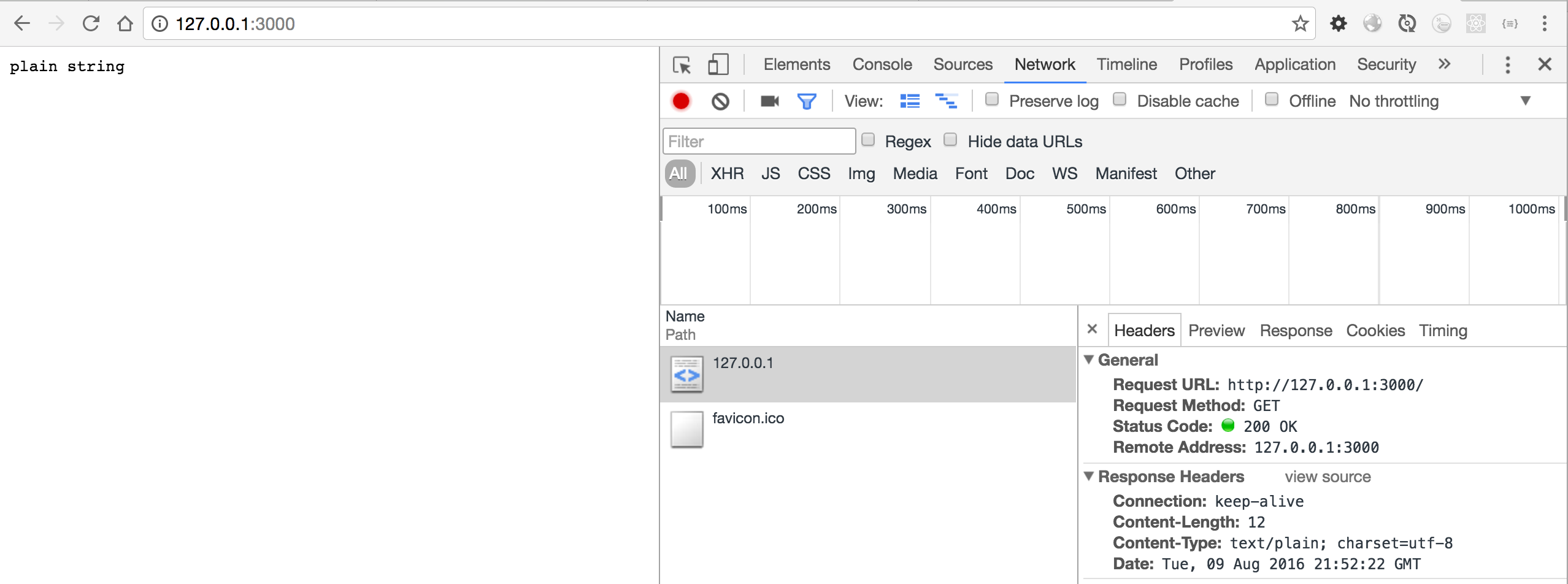
注意此时的“Content-Type:text/plain; charset=utf-8”
这种用到的可能性是极其小的,大家了解一下即可
html
stuq-koa-examples/koa-practice/http/content-type/html.js
const Koa = require('koa');
const app = new Koa();
// response
app.use(ctx => {
ctx.body = "<h1>plain html<h1>"
});
app.listen(3000);
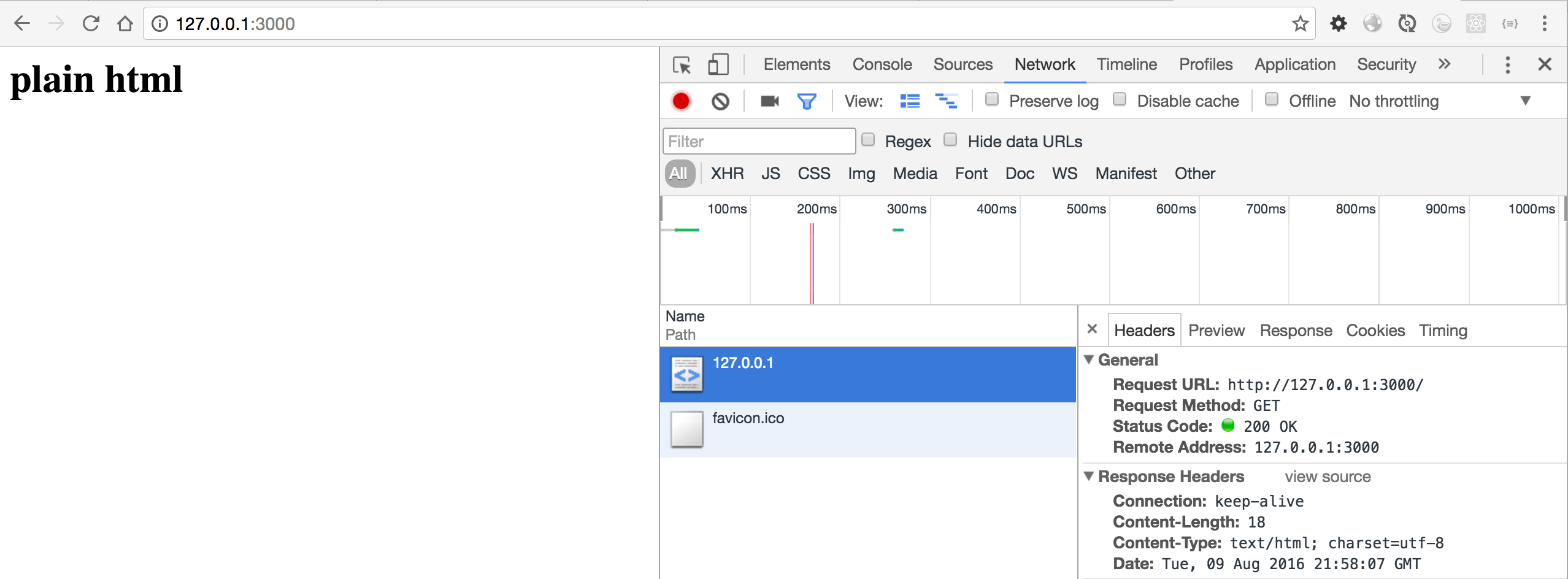
Content-Type:text/html; charset=utf-8
很明显,返回html就在浏览器里渲染各种html标签,这是我们在浏览器里最常用的做法。所谓的网站等等也都是这样的。
json对象
const Koa = require('koa');
const app = new Koa();
// response
app.use(ctx => {
ctx.body = {
"a":"1",
"b": 2
}
});
app.listen(3000);
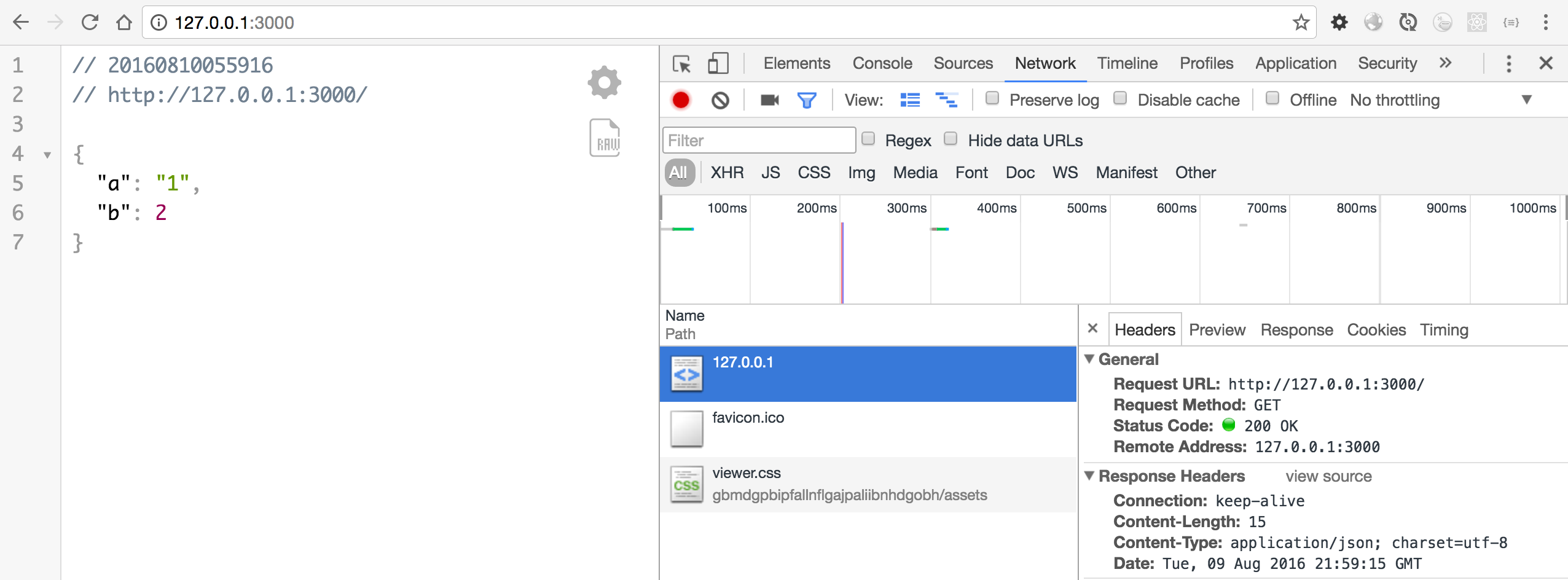
Content-Type:application/json; charset=utf-8
说明
返回json是api或者说前后端分离的常用方式。传输数据的方式一般是xml和json,但由于xml冗余等问题,除了编写web service外,绝大部分我们都会采用json这种轻量级的方式。
目前open api大部分也都是返回json数据的
更多见客户端 API 开发总结
使用模板渲染
我们再想想,如果返回的不是html string,而是模板呢?
模板引擎是一种复用思想,通过定义模板,用的时候和数据一起编译,生成html,以便浏览器渲染。从这个定义里我们可以找出几个关键点
编译(模板 + 数据) => html
举例
先来集成koa-views,其核心是consolidate.js,一个支持Node.js里大量模板引擎的库。
$ npm i -S koa-views@next
$ npm i -S pug
app.js
const Koa = require('koa')
const app = new Koa()
const views = require('koa-views')
// Must be used before any router is used
app.use(views(__dirname, { extension: 'pug' }))
// response
app.use(ctx => {
return ctx.render('user', {
user: 'John'
});
})
app.listen(3000)
要点1: 引用库文件
const views = require('koa-views')
要点2: 进行配置
// Must be used before any router is used
app.use(views(__dirname, { extension: 'pug' }))
要点3:使用ctx.render
// response
app.use(ctx => {
ctx.render('dir/index', {
a: 1
})
});
- 'dir/index'指的是模板文件位置
- {a:1}是数据
那么render编译后会生成html,讲html string赋值给ctx.body,是不是就可以展示html了?
模板引擎有好多种,下面介绍2种典型的模板引擎
- ejs:嵌入js语法的模板引擎(e = embed),类似于jsp,asp,erb的,在html里嵌入模板特性,如果熟悉html写起来就非常简单,只要区分哪些地方是可变,哪些地方是不变即可
- jade:缩进式极简写法的模板引擎,发展历史 HAML -> Jade -> Slim -> Slm,最早是ruby里有的,目前以jade用的最多,这种写法虽好,,但需要大脑去转换,这其实是比较麻烦的,如果对html不是特别熟悉,这种思维转换是非常难受的。
更多见
- https://github.com/tj/consolidate.js#supported-template-engines
- https://cnodejs.org/topic/57353cc040b2969853981250
总结
所有渲染都无外乎以下2种
- 直接渲染: string 有2种文本和html,衍生出使用模板引擎编译生成html
- 用做api: json object
其实了解html和koa的模板引擎如何渲染,就已经可以开发网站了。只有api开发,相对高级一点点,一般大些的项目才会使用的。
表单传值
上一节我们以表单为例介绍了HTTP请求,那么请求发到服务器了,我么该做什么呢?如何取参数呢? koa2里的请求参数,都是在ctx.request上,这里主要讲get和post请求。
- ctx.query === ctx.request.query
- ctx.path === ctx.request.path
- ctx.request.body
ctx.query
这里的query是querystring的别名
说明:ctx.query 不一定是get请求,因为querystring可以存在get或post请求里。
Koa最简单的获取querystring参数
创建文件 http/query/app.js
const Koa = require('koa');
const app = new Koa();
// response
app.use(ctx => {
ctx.body = 'Hello Koa-' + ctx.query['a'];
});
app.listen(3000);
注:ctx.query是ctx.request.query的别名,即ctx.query === ctx.request.query 。
启动服务器
$ node query/app.js
然后访问http://127.0.0.1:3000/?a=1,此时页面显示“Hello Koa-1”,这里的1即ctx.query['a']
提问
ctx.query只有get里可以用么?
根据ctx.path判断
如果我们想访问http://127.0.0.1:3000/topic?a=1呢?
http/query/app-2.js代码
const Koa = require('koa');
const app = new Koa();
// response
app.use(ctx => {
if (ctx.path === '/topic') {
ctx.body = ' Hello Koa ' + ctx.path + ' a='+ ctx.query['a'];
}
ctx.body = ' Hello Koa with default path = ' + ctx.path ;
});
app.listen(3000);
启动服务器
$ node query/app-2.js
访问http://127.0.0.1:3000/topic?a=1
返回Hello Koa /topic a=1
如果此时访问http://127.0.0.1:3000/?a=1呢?
返回Hello Koa with default path = /
总结一下
- ctx.path 是请求的路径
- ctx.query 获取的querystring
- ctx.body 是返回浏览器页面的文本
以/topic?a=1为例
- ctx.path === '/topic'
- ctx.query === '?a=1'
这样便于大家理解path和query的含义。
下面,我们想一下这里处理了2个请求,请求1是/topic,请求2是/topic以外的其他请求。如果我们再往极限一点想呢?比如有10个、100个请求怎么办?写一个无数个if/else么?
关于querystring的几种写法
// GET /search?q=tobi+ferret
ctx.query.q
// => "tobi ferret"
// GET /shoes?order=desc&shoe[color]=blue&shoe[type]=converse
ctx.query.order
// => "desc"
ctx.query.shoe.color
// => "blue"
ctx.query.shoe.type
// => "converse"
因为有变态的写法
// POST /search?q=tobi+ferret
{a:1,b:2}
ctx.query.q
// => "tobi ferret"
post里看不到的,用ctx.request.body取。
ctx.request.body
ctx.request.body一定是post请求,因为get的请求头里没有request.body。并且在koa中没有内置,需要依赖的中间件bodyParser,不然ctx.request.body是没有的。
本章节使用的是koa2,所以需要安装koa-bodyparser@next模块
npm install koa-bodyparser@next --save
包含在请求正文中提交的键值对数据,默认是undefined,当使用body-parsing中间件时ctx.request.body是内置在中间件中的,如 body-parser和multer中间件。
下面例子展示如何使用 body-parsing 中间件里的 ctx.request.body。 注意区分 ctx.body 和ctx.request.body 的区别,它们是完全不同的。
const Koa = require('koa');
const bodyParser = require('koa-bodyparser');
const app = new Koa();
app.use(bodyParser());
// response
app.use(ctx => {
// the parsed body will store in this.request.body
// if nothing was parsed, body will be an empty object {}
console.log(ctx.request.body)
ctx.body = ctx.request.body;
});
app.listen(3000);
当我们在浏览器里访问http://127.0.0.1:3000它的时候,是GET请求,此时ctx.request.body默认为空。
所以我们为了能够更清楚看到解析的post请求,所以我们使用chrome的postman插件查看

此时可以看到返回值是
{
"a": "1"
}
ctx.params(暂时不能用)
但可在router中使用: 新建app.js
const Koa = require('koa');
const router = require ('koa-router')();
const app = new Koa();
app.use(router.routes())
.use(router.allowedMethods());
router.get('/user/:id', function (ctx,next){
ctx.body = 'user ' + ctx.params.id;
});
app.listen(3000);
启动服务器
$ node app.js
然后访问http://127.0.0.1:3000/user/:id=10 会显示user :id=10。
以html表单的方式测试get和post请求
get
创建服务器 (http/get/app.js):
const Koa = require('koa');
const bodyParser = require ('koa-bodyparser');
const route = require('koa-router')();
const app = new Koa();
app.use(bodyParser());
app.use(require('koa-static')(__dirname + '/public'));
app.use(route.routes())
.use(route.allowedMethods());
route.get('/topic', function (ctx, next) {
ctx.body = 'Hello koa' + ctx.query['a'];
console.log (ctx.query['vehicle']);
});
app.listen(3000);
启动服务器
$ node get/app.js
创建一段html表单代码(http/public/get.html):
<form method="GET" action="/topic">
<input type="text" name="a" value='1'><br><br>
<input type="radio" name="sex" value="male">Male<br><br>
<input type="radio" name="sex" value="female">Female<br><br>
<input type="checkbox" name="vehicle" value="Bike">I have a bike<br><br>
<input type="checkbox" name="vehicle" value="Car">I have a car<br><br>
<input type="submit" value="OK">
</form>
访问http://127.0.0.1:3000/get.html地址,点击OK按钮,会向'/topic'提交GET请求

在shell中输出
Car
从上图可以看出,表单里的get数据实际会在url里的querystring里,会显示出来。
post
创建服务器 (http/post/app.js):
const Koa = require('koa');
const bodyParser = require ('koa-bodyparser');
const route = require('koa-router')();
const app = new Koa();
app.use(bodyParser());
app.use(require('koa-static')(__dirname + '/public'));
// routes definition
app.use(route.routes())
.use(route.allowedMethods());
route.post('/toc/aaa', function (ctx, next) {
ctx.body = ctx.request.body['a'];
console.log (ctx.request.body['vehicle']);
});
app.listen(3000);
启动服务器
$ node post/app.js
创建一段html表单代码(http/public/post.html):
<form method="POST" action="/toc/aaa">
<input type="text" name="a" value='1'><br><br>
<input type="radio" name="sex" value="male">Male<br><br>
<input type="radio" name="sex" value="female">Female<br><br>
<input type="checkbox" name="vehicle" value="Bike">I have a bike<br><br>
<input type="checkbox" name="vehicle" value="Car">I have a car<br><br>
<input type="submit" value="OK">
</form>
访问http://127.0.0.1:3000/post.html地址,会向'/toc/aaa'提交POST请求

点击OK按钮

从上图可以看出,表单里的post数据实际是不会在url里的querystring里。
上传
安装中间件
$ npm install --save koa-multer
Koa中上传基本用法
创建上传文件存储目录:(http/uploads) 创建服务器 (http/app.js)
const Koa = require('koa'); // v2
const router = require('koa-router')(); // v6
const multer = require('koa-multer');
const app = new Koa();
const upload = multer({ dest: 'uploads/' });
app.use(require('koa-static')(__dirname + '/public'));
app.use(router.routes())
.use(router.allowedMethods());
router.post('/profile', upload.single('upfiles'),function (ctx, next){
ctx.body = "upload is success";
});
app.listen(3000);
see more https://github.com/koa-modules/multer 和 https://github.com/expressjs/multer
启动服务器
$ node app.js
创建一段html表单代码:(http/public/upload.html)
<form method="POST" action="/profile" enctype='multipart/form-data'>
请选择上传的文件:<input type="file" name="upfiles">
<input type="submit" value="OK">
</form>
访问http://127.0.0.1:3000/upload.html地址
选择要上传的文件

上传成功

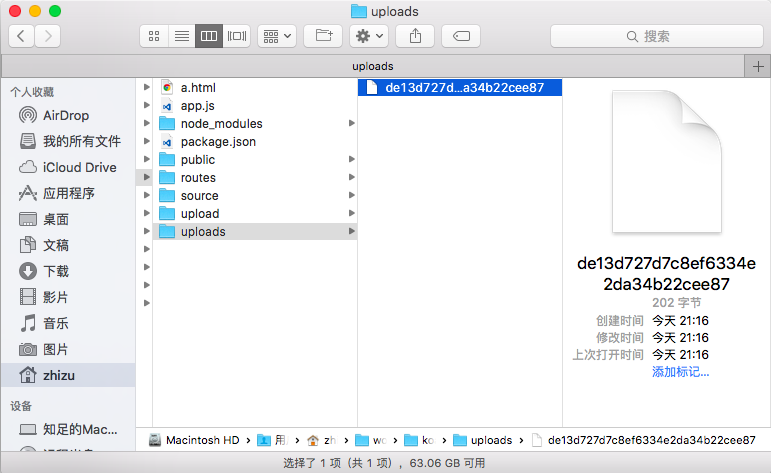
比较一下get和post请求
- get更适合获取、搜索类的请求,url暴露在外面
- post请求适合安全性更改,如创建xx等
- 另外还有一点就是post能处理的表单内容比get要大非常多,后面会讲
Ajax异步请求
上一节讲了form传值,这是最基本的传值方式。这节我们讲一下我们最常用的ajax传值。 仍然按照我们之前讲过的
- get/post/上传
什么是 ajax
Ajax即“Asynchronous Javascript And XML”(异步JavaScript和XML),是指一种创建交互式网页应用的网页开发技术。核心是XMLHttpRequest对象(简称XHR),可以通过使用XHR对象获取到服务器的数据,然后再通过DOM将数据插入到页面中呈现。虽然名字中包含XML,但Ajax通讯与数据格式无关,所以我们的数据格式可以是XML或JSON等格式。
XMLHttpRequest对象用于在后台与服务器交换数据,具体作用如下:
- 在不重新加载页面的情况下更新网页
- 在页面已加载后从服务器请求数据
- 在页面已加载后从服务器接收数据
- 在后台向服务器发送数据
四步
- 通过事件触发ajax请求
- 发送ajax请求
- 处理ajax请求结果,无论成功还是失败
- 处理完成后,根据业务,对页面进行dom操作或css样式操作
比较传统表单和ajax异同

TODO: 比较
示例helloworld演示
$ cd book-source/http/ajax/helloworld
$ ls
ajax_info.txt index.html
$ hs . -p 9090 -o
Starting up http-server, serving .
Available on:
http://127.0.0.1:9090
http://192.168.1.105:9090
Hit CTRL-C to stop the server
[Thu May 26 2016 22:32:54 GMT+0800 (CST)] "GET /" "Mozilla/5.0 (Macintosh; Intel Mac OS X 10_10_5) AppleWebKit/537.36 (KHTML, like Gecko) Chrome/50.0.2661.102 Safari/537.36"
[Thu May 26 2016 22:32:55 GMT+0800 (CST)] "GET /favicon.ico" "Mozilla/5.0 (Macintosh; Intel Mac OS X 10_10_5) AppleWebKit/537.36 (KHTML, like Gecko) Chrome/50.0.2661.102 Safari/537.36"
[Thu May 26 2016 22:32:55 GMT+0800 (CST)] "GET /favicon.ico" Error (404): "Not found"
启动服务器命令说明
- hs 是node模块http-server的简写命令,用于启动http服务器
-p 9090是设置端口的意思-o在默认浏览器里打开网址
源码说明
- ajax_info.txt 文本文件,返回一段文字
- index.html 所有的代码
源码解析
index.html
<!DOCTYPE html>
<html>
<head>
<meta charset='uft-8' />
<title> ajax hello world </title>
</head>
<body>
<div id="demo"><h2>把AJAX返回的数据放到这里</h2></div>
<button type="button" onclick="send_ajax_request()">改变内容</button>
<script>
function send_ajax_request() {
var xhr = new XMLHttpRequest();
xhr.onreadystatechange = function() {
if (xhr.readyState == 4 && xhr.status == 200) {
// dom
document.getElementById("demo").innerHTML = xhr.responseText;
// style
document.getElementById('demo').style.background = "lightblue";
}
};
xhr.open("GET", "ajax_info.txt", true);
xhr.send();
}
</script>
</body>
</html>
四步骤要点
- 通过事件触发ajax请求
给按钮增加onclick事件,在点击的时候调用send_ajax_request()
<button type="button" onclick="send_ajax_request()">改变内容</button>
- 发送ajax请求(此时是request发送)
var xhr = new XMLHttpRequest();
xhr.onreadystatechange = function() {
if (xhr.readyState == 4 && xhr.status == 200) {
...
}
};
xhr.open("GET", "ajax_info.txt", true);
xhr.send();
在创建XHR对象后,接着我们要调用一个初始化方法open(),它接受五个参数具体定义如下:
void open(
DOMString method, //"GET", "POST", "PUT", "DELETE"
DOMString url,
optional boolean async,
optional DOMString user,
optional DOMString password
);
这是完成的ajax请求代码,实际发送请求是通过send方法,即
xhr.send();
- 处理ajax请求结果,无论成功还是失败(此时是response处理)
if (xhr.readyState == 4 && xhr.status == 200) {
// dom
document.getElementById("demo").innerHTML = xhr.responseText;
// style
document.getElementById('demo').style.background = "lightblue";
}
onreadystatechange 事件
当请求被发送到服务器时,我们需要执行一些基于响应的任务。每当 readyState 改变时,就会触发 onreadystatechange 事件。readyState 属性存有 XMLHttpRequest 的状态信息。
readyState属性 存有 XMLHttpRequest 的状态。从 0 到 4 发生变化( 每个请求发送onreadystatechange 事件就会被触发 5 次(0 - 4),对应着 readyState 的每个变化。)
- 0: 请求未初始化
- 1: 服务器连接已建立
- 2: 请求已接收
- 3: 请求处理中
- 4: 请求已完成,且响应已就绪
status是http状态码,给出常见的几种
- 500 : 'Internal Server Error服务器内部错误',
- 403 : 'Forbidden禁止访问',
- 404 : 'Not Found未找到页面',
- 304 : 'Not Modified没有更改',
- 200 : 'OK',
在 onreadystatechange 事件中,我们规定当服务器响应已做好被处理的准备时所执行的任务。
当 readyState 等于 4 且状态为 200 时,表示响应已就绪,即此时你可以对response返回的数据或文本进行处理。
- 处理完成后,根据业务,对页面进行dom操作或css样式操作
对页面进行dom操作
document.getElementById("demo").innerHTML = xhr.responseText;
对页面进行css样式操作
document.getElementById('demo').style.background = "lightblue";
问题
- 连续点击【改变内容】按钮,为什么不再改变?
- 为什么刷新会回到之前的内容?
这里response(服务器响应)处理的文本,那么用的最多的是什么呢?
如需获得来自服务器的响应,请使用 XMLHttpRequest 对象的 responseText 或 responseXML 属性。
- xhr.responseText 获得字符串形式的响应数据。
- xhr.responseXML 获得 XML 形式的响应数据。
可以任意类型,主要有
- xml(使用xhr.responseXML)
- text文本(xhr.responseText)
- json(xhr.responseText)
虽然ajax里面的x是xml的意思,但实际情况xml用的极其的少,除了web service外,绝大部分情况我们会使用json作为服务端响应数据类型
一般讲,api开发(Application Programming Interface)泛指以返回json作为接口的服务端编程。
简单的json api示例
$ cd book-source/http/ajax/json
$ hs . -p 9091 -o
$ ls
data.json index.html
源码说明
- data.json 文本文件,返回json对象
- index.html 所有的代码
data.json
{
"content": "ajax_info里的数据"
}
index.html
<!DOCTYPE html>
<html>
<head>
<meta charset='uft-8' />
<title> ajax with json </title>
</head>
<body>
<div id="demo"><h2>把AJAX返回的数据放到这里</h2></div>
<button type="button" onclick="send_ajax_request()">改变内容</button>
<script>
function send_ajax_request() {
var xhr = new XMLHttpRequest();
xhr.onreadystatechange = function() {
if (xhr.readyState == 4 && xhr.status == 200) {
// json parse
var data = JSON.parse(xhr.responseText)
// dom
document.getElementById("demo").innerHTML = data.content;
// style
document.getElementById('demo').style.background = "lightblue";
}
};
xhr.open("GET", "data.json", true);
xhr.send();
}
</script>
</body>
</html>
相比较之前的text方式,差异如下
1)请求地址变了,是"data.json"
xhr.open("GET", "data.json", true);
2)处理完成后,先解析xhr.responseText为json,对页面进行dom操作或css样式操作
if (xhr.readyState == 4 && xhr.status == 200) {
// 先解析xhr.responseText为json
var data = JSON.parse(xhr.responseText)
// dom
document.getElementById("demo").innerHTML = data.content;
// style
document.getElementById('demo').style.background = "lightblue";
}
其他操作都是一样的。
ajax与表单
上节讲了表单是用来页面之间传值用的,无论get还是post,它都会跳转到action对应的页面。而ajax是在当前页面就可以完成请求与响应,无需跳转,这是它们之间的差异。它们各自有各自的特点,比如
- 有些页面是需要跳转的,比如登录、注册
- 大部分页面为了有更好的体验,使用ajax,无刷新页面完成请求
那么ajax如何实现和表单一样的传值呢?
GET 还是 POST?
与 POST 相比,GET 更简单也更快,并且在大部分情况下都能用。
然而,在以下情况中,请使用 POST 请求:
- 无法使用缓存文件(更新服务器上的文件或数据库)
- 向服务器发送大量数据(POST 没有数据量限制)
- 发送包含未知字符的用户输入时,POST 比 GET 更稳定也更可靠
写一个接口
使用koa编写这个demo,用到2个模块就够了
1) 第一步npm init,会生成package.json文件
2) 安装依赖
$ npm i -S koa@next
$ npm i -S koa-static@next
在package.json里会自动增加2条依赖
"dependencies": {
"koa": "^2.0.0",
"koa-static": "^3.0.0"
}
3) 创建app.js
$ touch app.js
在app.js里放入下面代码即可
var serve = require('koa-static');
var Koa = require('koa');
var app = new Koa();
// 启用静态httpserver
app.use(serve(__dirname + '/public'));
// 定义json接口
app.use(ctx => {
if (ctx.path === '/api/json') {
ctx.body = {
"content": "ajax_info里的数据"
}
} else {
ctx.body = {
"error": "请使用 /api/json 作为请求地址"
}
}
});
app.listen(3000);
console.log('listening on port 3000');
说明
- 启用静态httpserver
- 定义了一个接口
4)启动、测试
$ node app.js
listening on port 3000
在浏览器里打开http://127.0.0.1:3000/api/json
返回如下
// 20160527073015
// http://127.0.0.1:3000/api/json
{
"content": "ajax_info里的数据"
}
加上参数
get
get请求是通过querystring进行传值
if (ctx.path === '/api/get_json_with_param') {
console.log(ctx.query)
var name = ctx.query.name
ctx.body = {
"content": "ajax_info里的数据",
"name": name
}
}
http://127.0.0.1:3000/api/get_json_with_param?name=i5ting
post
koa默认是不支持post请求的,需要使用bodyparser模块
npm i -S koa-bodyparser@next
修改app.js代码
var serve = require('koa-static');
var bodyParser = require('koa-bodyparser');
var Koa = require('koa');
var app = new Koa();
// 处理post请求
app.use(bodyParser());
// 启用静态httpserver
app.use(serve(__dirname + '/public'));
下面来看一下post请求代码如何处理
if (ctx.path === '/api/post_json_with_param') {
console.log(ctx.request.body)
var name = ctx.request.body.name
ctx.body = {
"content": "ajax_info里的数据",
"name": name
}
}
get请求可以在浏览器里显示的测试,而post是不能直接通过url测试的,所以为了简便,我们这里使用chrome的插件postman测试。注意post的类型是x-www-form-urlencoded。
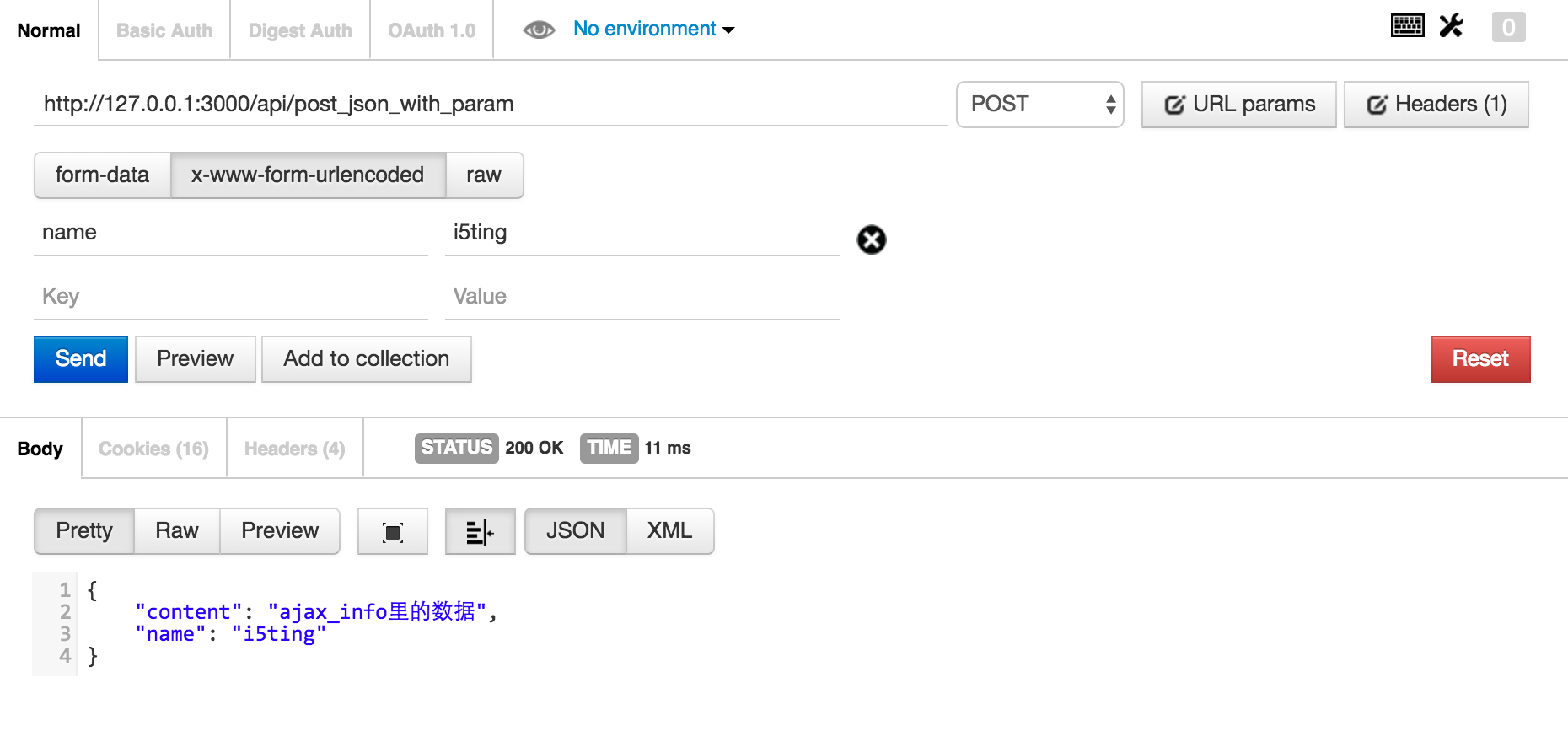
总结
至此,我们把koa的get和post返回json api的代码就都讲完了,有了这些api,我们就可以尝试ajax和json api进行联调。
联调
get
点击 【发送get请求】按钮触发get请求
<button type="button" onclick="send_get_request()">发送get请求</button>
如果您希望通过 GET 方法发送信息,请向 URL 添加信息:
function send_get_request() {
var xhr = new XMLHttpRequest();
xhr.onreadystatechange = function() {
if (xhr.readyState == 4 && xhr.status == 200) {
// json parse
var data = JSON.parse(xhr.responseText)
// dom
document.getElementById("demo").innerHTML = data.content;
// style
document.getElementById('demo').style.background = "green";
}
};
xhr.open("GET", "/api/get_json_with_param?name=i5ting", true);
xhr.send();
}
post
点击 【发送post请求】按钮触发post请求
<button type="button" onclick="send_post_request()">发送post请求</button>
如果需要像 HTML 表单那样 POST 数据,请使用 setRequestHeader() 来添加 HTTP 头。然后在 send() 方法中规定您希望发送的数据:
function send_post_request() {
var xhr = new XMLHttpRequest();
xhr.onreadystatechange = function() {
if (xhr.readyState == 4 && xhr.status == 200) {
// json parse
var data = JSON.parse(xhr.responseText)
// dom
document.getElementById("demo").innerHTML = data.content;
// style
document.getElementById('demo').style.background = "red";
}
};
xhr.open("POST", "/api/post_json_with_param", true);
xhr.setRequestHeader("Content-type","application/x-www-form-urlencoded");
xhr.send("name=i5ting");
}
demo
http://127.0.0.1:3000/test.html
表单取值
此时我们的请求还是没有任何输入的,因为我们都给固定死了,这其实是为了演示方便,但绝大部分情况是不会这样的,都有正常的输入。
结合我们讲的ajax流程的4个步骤,想想,如果动态取表单里的值,然后ajax,应该是什么样的流程?
ajax完整5步骤
- 通过事件触发ajax请求
- 通过dom获取表单数据值
- 组装表单数据值,发送ajax请求
- 处理ajax请求结果,无论成功还是失败
- 处理完成后,根据业务,对页面进行dom操作或css样式操作
这里以get请求举例
function send_get_request() {
var xhr = new XMLHttpRequest();
xhr.onreadystatechange = function() {
if (xhr.readyState == 4 && xhr.status == 200) {
// json parse
var data = JSON.parse(xhr.responseText)
// dom
document.getElementById("demo").innerHTML = "get返回的结果" + data.name;
// style
document.getElementById('demo').style.background = "green";
}
};
var myname = document.getElementById("myname").value
xhr.open("GET", "/api/get_json_with_param?name=" + myname, true);
xhr.send();
}
说明
1)dom获取表单数据
var myname = document.getElementById("myname").value
2) 组装ajax要传送的表单数据
xhr.open("GET", "/api/get_json_with_param?name=" + myname, true);
这里是get,所以在querystring里组装
如果是post
function send_post_request() {
var xhr = new XMLHttpRequest();
xhr.onreadystatechange = function() {
if (xhr.readyState == 4 && xhr.status == 200) {
// json parse
var data = JSON.parse(xhr.responseText)
// dom
document.getElementById("demo").innerHTML = "post返回的结果" + data.name;
// style
document.getElementById('demo').style.background = "red";
}
};
xhr.open("POST", "/api/post_json_with_param", true);
xhr.setRequestHeader("Content-type","application/x-www-form-urlencoded");
var myname = document.getElementById("myname").value
xhr.send("name=" + myname);
}
1) 需要设置xhr.setRequestHeader
xhr.setRequestHeader("Content-type","application/x-www-form-urlencoded");
2)表单传值不在querystring,而是直接放到send方法里,写法和querystring一样。
xhr.send("name=" + myname);
例子book-source/http/ajax/koa-json/public/test.html ,请访问 http://127.0.0.1:3000/form.html
jQuery ajax
通过 jQuery AJAX 方法,您能够使用 HTTP Get 和 HTTP Post 从远程服务器上请求文本、HTML、XML 或 JSON - 同时您能够把这些外部数据直接载入网页的被选元素中。 如果没有 jQuery,AJAX 编程还是有些难度的。 编写常规的 AJAX 代码并不容易,因为不同的浏览器对 AJAX 的实现并不相同。这意味着您必须编写额外的代码对浏览器进行测试。不过,jQuery 团队为我们解决了这个难题,我们只需要一行简单的代码,就可以实现 AJAX 功能。
在使用Ajax前,需要下载jQuery库,并在页面中引入<script src="jquery.js"></script>。
我们这里使用最多的jQuery库举例
$.get("test.cgi", { name: "John", time: "2pm" }, function( data ) {
// 处理ajax请求结果
alert( "Data Loaded: " + data );
// 根据业务,对页面进行dom操作或css样式操作
$(sss).html().css()
});
- 使用$.get或$.post发送ajax请求。可以理解它是对原生的xhr封装
- 在回调中
function( data ) {}里处理ajax请求结果 $(sss).html().css()对页面进行dom操作或css样式操作
https://github.com/DevMountain/mini-ajax
jQuery Ajax使用方法与 Ajax 相似,写接口、创建服务器、启动服务器,与Ajax相同,这里不再重复。
给出app.js 源码
var koa = require ('koa');
var serve = require ('koa-static');
var bodyParser = require ('koa-bodyparser');
var app = new koa();
app.use (bodyParser());
app.use (serve(__dirname + '/public'));
app.use ( ctx => {
if(ctx.path === '/api/get_json_with_param'){
console.log(ctx.query);
var name = ctx.query.name;
ctx.body = {
"content":"ajax_info里的数据",
"name": name
}
} else if (ctx.path === '/api/post_json_with_param') {
console.log(ctx.request.body)
var name = ctx.request.body.name
ctx.body = {
"content": "post_json_with_param里的数据",
"name": name
}
} else {
ctx.body = {
"error":"请使用 /api/json 作为请求地址"
}
}
});
app.listen(3000);
console.log ("listening on port 3000");
启动服务器
$node app.js
以表单为例,介绍如何使用$.get或$.post发送ajax请求
同样5步骤
- 通过事件触发ajax请求
- 通过dom获取表单数据值
- 组装表单数据值,发送ajax请求
- 处理ajax请求结果,无论成功还是失败
- 处理完成后,根据业务,对页面进行dom操作或css样式操作
引入jQuery 库
<head>
<meta charset='uft-8' />
<title> ajax with json </title>
<script src="/script/jquery.js"></script>
</head>
get
$.get(url,[data],[callback])
- url (String) 发送请求的URL地址.
- data (Map)(可选参数) 要发送给服务器的数据,以 Key/value 的键值对形式表示,会做为QueryString附加到请求URL中
- callback (Callback) (可选参数) 载入成功时回调函数(只有当Response的返回状态是success才是调用该方法),该函数接受两个参数,第一个为服务器返回的数据,第二个参数为服务器的状态。
<form>
<input type='text' name='username' value='i5ting' id='myname'/>
<div id="demo"><h2>把AJAX返回的数据放到这里</h2></div>
<button id="bt1" type="button">发送get请求</button>
<button id="bt2" type="button">发送post请求</button>
</form>
<script>
$('#bt1').click( function () { // 触发ajax请求
var name1 = $("#myname").val(); // 获取表单数据值
console.log(name1); // 打印取到的表单值
$.get ('/api/get_json_with_param', {name:name1}, function (data,status) {
// function (data,staus)中,data为服务器返回数据,status为服务器状态
$('#demo').html("get返回的结果" + data.name).css('background','lightblue');
console.log (data); // 打印返回数据
});
});
</script>
post
$.post(url,[data],[callback],[type])
这个函数跟$.get()参数差不多。
- url (String) 发送请求的URL地址.
- data (Map)(可选参数) 要发送给服务器的数据,以 Key/value 的键值对形式表示
- callback (Callback) (可选参数) 载入成功时回调函数(只有当Response的返回状态是success才是调用该方法)
- type (String) (可选参数) 请求数据的类型,xml,text,json等,如果我们设置这个参数为:json,那么返回的格式则是json格式的,如果没有设置,就 和$.get()返回的格式一样,都是字符串的
<form>
<input type='text' name='username' value='i5ting' id='myname'/>
<div id="demo"><h2>把AJAX返回的数据放到这里</h2></div>
<button id="bt1" type="button">发送get请求</button>
<button id="bt2" type="button">发送post请求</button>
</form>
<script>
$('#bt2').click( function () {
var name1 = $("#myname").val();
console.log(name1);
$.post ('/api/post_json_with_param', {name:name1},function (data,status) {
$('#demo').html("post返回的结果" + data.name).css('background','red');
console.log (data); // 打印返回数据
});
});
</script>
upload
增加router
npm i -S koa-router@next
npm install --save koa-multer
具体代码
const Koa = require('koa')
const app = new Koa()
var router = require ('koa-router')();
const views = require('koa-views')
const multer = require('koa-multer');
const upload = multer({ dest: 'uploads/' });
// Must be used before any router is used
app.use(views(__dirname, { extension: 'pug' }))
router.post('/profile', upload.single('avatar'), ctx => {
return ctx.render('user', {
user: 'sucess upload file'
});
});
app
.use(router.routes())
.use(router.allowedMethods());
app.listen(3000)
要实现上传功能,需要借助插件。 推荐koa-uploadify https://github.com/i5ting/uploadify/tree/revert-2-koa-uploadify 可以把源码下载下来研究一下。
总结
使用jQuery Ajax 相对简单,易于理解,而且它要小好多。